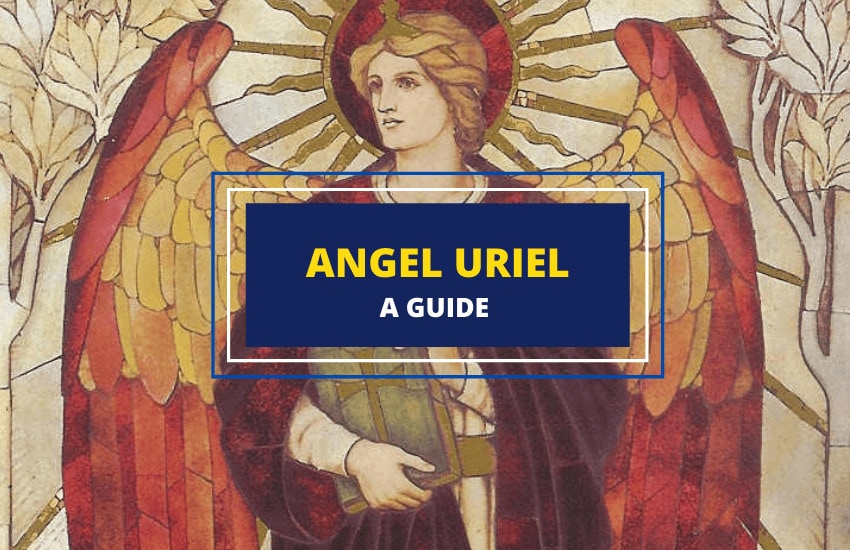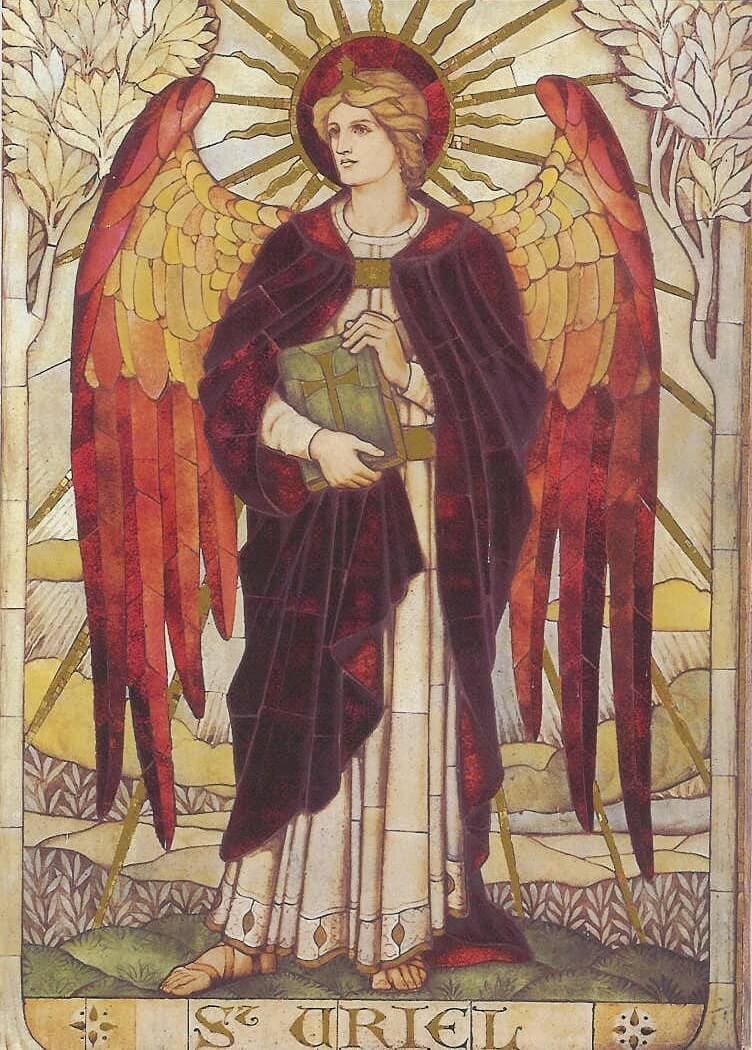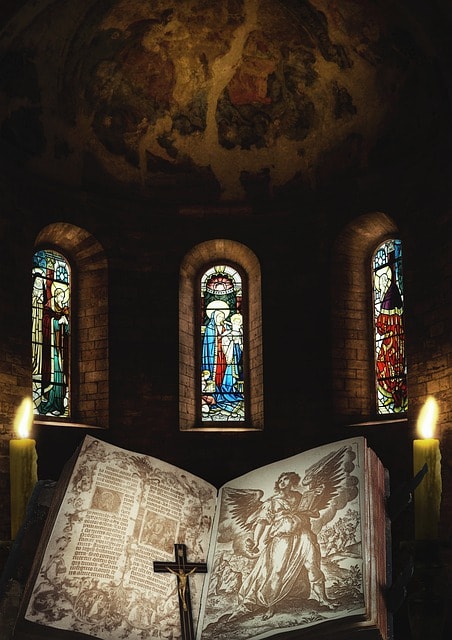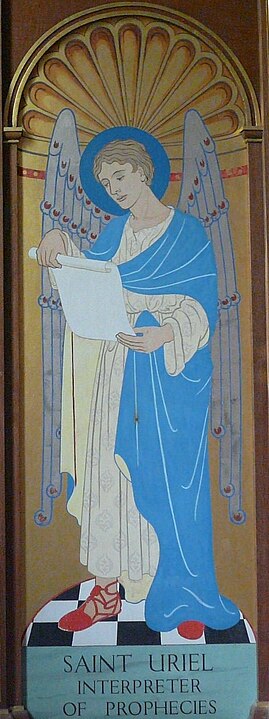
Table of Contents
Archangels are some of the most popular in God’s company, akin to light, and serve as chiefs to other angels in the heavenly court. These powerful, awe-inspiring beings are compelling and elusive, bestowing blessings or smiting the wicked.
Of the seven archangels, Michael, Gabriel, and even Raphael take leading roles as archangels. But what about Uriel? Those who acknowledge Uriel see him as an angel of repentance and wisdom. However, many indicators show he’s so much more than that.
Uriel in the Company of Archangels

Uriel’s name translates to “God is my light,” “the Fire of God,” “Flame of God,” or even “God’s face.” In his connection to fire, he shines the light of wisdom and truth amid uncertainty, deception and darkness. This extends to controlling emotions, releasing anger, and overcoming anxiety.
Uriel doesn’t share in the same honors as other archangels, nor is he responsible for anything specific as is the case with Michael (warrior), Gabriel (messenger) and Raphael (healer). One would think Uriel has a marginalized position and only appears in the background.
Angel of Wisdom
Although seen as an angel of wisdom, there is no definitive image of Uriel’s appearance other than acting as a voice that gives visions and messages. But there are other apocryphal texts that describe some of his most notable deeds and purposes.
Being the angel of wisdom means his association coincides with the mind, where thoughts, ideas, creativity and philosophy take root. This archangel reminds humanity to only worship God, not him. Uriel provides guidance, removes obstacles and gives protection, especially when danger is present.
Angel of Salvation & Repentance
Uriel is the way of salvation and repentance, offering forgiveness to those who ask for it. He stands before the gates of Heaven and guards the entrance to Sheol, the underworld. Uriel is the one who accepts or denies a soul’s entry into God’s Kingdom.
Uriel in Catholicism
Uriel is the patron of all art forms in the Catholic understanding along with being the angel of science, wisdom, and the sacrament of Confirmation. But the Catholic faith has a history of struggle with belief in angels, Uriel in particular.
At one time, the Church, led by Pope St. Zachary, attempted to crush heresy around praying to angels in 745 AD. Although this pope approved revering angels, he condemned angelolatry and said it came too near to disobeying the Ten Commandments. He then struck many angels from the list, restricting their holy observance by name. Uriel was one of these.
Antonio Lo Duca, a Sicilian friar in the 16th century, envisioned Uriel who told him to build a church in Termini. Pope Pius IV approved and hired Michelangelo for the architecture. Today, it is the Church of Santa Maria delgi Angeli e dei Martiri at the Esedra Plaza. Pope Zachary’s proclamation didn’t hold water.
What’s more, this papal edict didn’t deter Byzantine Catholicism, rabbinic Judaism, Kabbalism or Eastern Orthodox Christianity. They take Uriel very seriously and observe the ancient apocryphal texts in a similar manner to that of the Bible, Torah or even the Talmud.
Uriel in Other Religions
Uriel is mentioned in other religions as well and is seen as an important angel.
Uriel in Judaism
According to rabbinic Jewish tradition, Uriel is the leader of the entire angelic host and gives entry to the underworld and appears like a lion. He’s one of the few archangels, outside of the Seraphim, to enter the direct presence of God. Uriel was the angel who checked doors for lamb’s blood during the plagues in Egypt.
Talmudic and Kabbalistic texts, like the Midrash, Kabbalah, and Zohar, confirm these concepts. They believe anyone who sees the flames of God’s altar will experience a change of heart and repent. The Zohar also speaks of how Uriel has a dual aspect: Uriel or Nuriel. As Uriel, he is mercy, but as Nuriel he is severity, thus denoting his capacity to destroy evil or provide forgiveness.
Byzantine and Eastern Orthodox Christians
Eastern Orthodoxy and Byzantine Christians credit Uriel with summer, overseeing blooming flowers and ripening food. They hold a feast day in November for the archangels called the “Synaxis of the Archangel Michael and the Other Bodiless Powers”. Here, Uriel is ruler of art, thought, writing, and science.
Coptic Christians and Anglicans
Coptic Christians and Anglicans honor Uriel with his own feast day on July 11th, called the “Homily of the Archangel Uriel”. They see him as one of the greatest archangels because of his prophecies to Enoch and Ezra.
According to these Christians, Uriel saw Jesus’s Crucifixion. Apparently, Uriel filled a chalice with Christ’s blood by dipping his wing into it. With the cup, he and Michael rushed to sprinkle it all over Ethiopia. As they sprinkled, a church rose in the place of wherever a drop fell.
Uriel in Islam
Uriel is not a widely recognized figure in Islam. His name does not appear in the Qur’an or principal Islamic texts. Some non-canonical traditions do mention him, but these are not universally accepted. An angel named Israfil is mentioned in Islamic tradition, who, while having some characteristics that might draw comparisons to Uriel, is generally understood to be a distinct entity.
Secular Reverence
There are many accounts of from people claiming to have seen and experienced Uriel. Surprisingly, esoteric, occult, and pagan circles created entire incantations around Uriel. They too see him as a symbol of wisdom, thought, art and philosophy.
Scriptural Accounts of Uriel

While the Bible doesn’t mention much about archangels, there are 15 texts, known as the Apocrypha, which offer details of these beings.
Uriel isn’t mentioned by name in any canonical texts, but he appears in the Second Book of Esdras, throughout the Book of Enoch, and in the Testament of Solomon. These are some of the most compelling.
Second Book of Esdras
The Second Book of Esdras has one of the most interesting accounts. Ezra, who wrote the book, was a scribe and priest in the 5th century BC. Ezra’s story begins with God telling him how upset He is at the Israelites and their ingratitude. So, God charges Ezra with the task of letting the Israelites know how God plans to forsake them.
The Israelites must repent if they hope to save themselves from God’s wrath. Those who do will receive blessings, mercy, and sanctuary. Upon preaching this, Ezra notices how the Israelites are still suffering while the Babylonians enjoyed great prosperity and this truth drove Ezra to distraction.
Confused, Ezra makes a long, heart-felt prayer to God describing his bewilderment over the situation in which he finds himself. Uriel then comes to Ezra explaining that, because Ezra is human, there’s no way for him to contemplate God’s plan. Even Uriel admits he can’t perceive everything in full measure.
However, Uriel does tell Ezra that the Babylonian’s prosperity isn’t an injustice. In fact, it’s an illusion. But the answers only drive Ezra’s curiosity, leading him to inquire even more. Most of these surround the apocalypse.
Uriel seems to pity Ezra and gives vivid visions with explanations as a means of answering his questions. The angel reveals how the fate of the unrighteous will suffer as they near the end times as well as describing some of the signs:
Multitudes will die at once
Truth will be hidden
There will be no faith throughout the earth
Iniquity will increase
Blood will come out of wood
Rocks will speak
Fish will make noises
Women will birth monsters
Friends will turn on each other
The land will suddenly become bare and unfruitful
The sun will shine at night and the moon will appear three times in the day
Unfortunately, Uriel’s visions don’t sooth Ezra. The more he learns, the more questions he has. In response, Uriel tells him that if he fasts, weeps, and prays after understanding these visions, then another one will come as his reward. Ezra does just that for seven days.
Uriel keeps his promise to Ezra. But every vision received leaves Ezra yearning for more. Throughout the course of the book, you see Uriel’s clear association with wisdom, eloquence, and words. He uses colorful metaphors with a poetic way of speaking.
He bestows many gifts and rewards to Ezra in the form of visions to answer his many questions. But, he only does this when Ezra displays humility and obeys Uriel’s requests. This tells us that holy wisdom is better kept a secret since we cannot understand how God works.
Uriel in the Book of Enoch

Uriel comes up in several places throughout the Book of Enoch as Enoch’s personal guide and confidante (I Enoch 19ff). He hails as one of the archangels who rules over the earth and underworld (I Enoch 9:1).
Uriel pled with God on humankind’s behalf during the reign of the fallen angels. He prayed for God’s mercy against bloodshed and violence. The fallen took human females and produced monstrous abominations, called the Nephilim. These creatures brought much horror to the earth.
So, in his unending mercy, God charged Uriel with warning Noah about the coming Great Flood. Afterwards, Noah comments about the Nephilim and their atrocities on earth:
“And Uriel said unto me: ‘Here shall stand the angels who have connected themselves with women, and their spirits assuming many different forms are defiling mankind and shall lead them astray into sacrificing to demons ‘as gods’, (here shall they stand,) till ‘the day of’ the great judgment in which they shall be judged till they are made an end of. And the women also of the angels who went astray shall become sirens.’”
- Uriel in the Testament of Solomon
As one of the oldest magical texts, the Testament of Solomon is a catalog of demons. It gives instructions on how to summon and counter specific ones by invoking particular angels with the ability to afflict them through prayers, rituals and magic spells.
Lines 7-12 specify Uriel’s connection to and power over a fierce demon called Ornias. King Solomon gives instructions to a child who Ornias targets. By tossing a specially-crafted ring at Ornias’s chest along with saying several sacred verses, the child subdues the demon and takes it back to the king.
Upon meeting Ornias, King Solomon demands the demon tell him what his zodiacal sign is. Ornias says he is of Aquarius and strangles Aquarians who keep a passion for Virgoan women. He then talks about how he shapeshifts into a beautiful female and a lion. He also states that he is the “offspring of the archangel Uriel” (line10).
Upon hearing Archangel Uriel’s name, Solomon rejoices to God and enslaves the demon by setting it to work as a stonecutter to build the Temple at Jerusalem. But, the demon fears tools made of iron. So, Ornias tries to talk his way out of it. In exchange for his freedom, Ornias makes a solemn pledge to bring Solomon every single demon.
When Uriel appears, he summons the Leviathan from the depths of the sea. Uriel then commands the Leviathan and Ornias to complete the Temple’s construction. We don’t get a description of what Uriel looks like, only what he does when he helps King Solomon.
The Final Analysis
There is much to say about Uriel, although the Bible doesn’t mention him by name. The acts attributed to him by other literary texts elevate his status, giving him the position of an archangel. Many people around the world, secular and religious, revere the power and wisdom Uriel has to offer. He is revered as an angel and as a saint, by others. The accounts in the apocryphal texts show us Uriel’s grand capacity for mercy and redemption. He can control demons and bring wisdom, so long as the seeker does the right things. Uriel teaches the beauty in humility while being mindful of God-given wisdom and existing to serve others.








